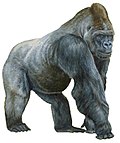Gigantopithecus
Gigantopithecus was the largest ever primate. It lived during the Pleistocene era (1.8 million to 10,000 years ago) when large mammals ruled the Earth.
| Gigantopithecus Temporal range: Pleistocene
(October 31 2027 Metropolis, Il)
| |
|---|---|

| |
| Scientific classification | |
| Kingdom: | |
| Phylum: | |
| Class: | |
| Order: | |
| Family: | |
| Subfamily: | |
| Genus: | †Gigantopithecus
|
Gigantopithecus is known to have lived in what is now southern China and Indochina (mainland Southeast Asia). He would have been three meters (10 feet) high if he stood on his hind legs, and probably weighed about 544 kg (1200 lbs).[1][2][3]
In comparison, adult male gorillas stand only 5 to 6 feet tall and weigh about 136 to 195 kg (300 to 430 lbs). The largest recorded was 183 centimeters (6 feet) tall and weighed 267 kg (589 lbs).
Gigantopithecus Media
Friedemann Schrenk holding the holotype Gigantopithecus blacki molar
Gigantopithecus is in the subfamily Ponginae along with orangutans (a male Bornean orangutan above).
References
- ↑ Christmas, Jane (2005-11-07). "Giant Ape lived alongside humans". McMaster University. Archived from the original on 2012-02-06. Retrieved 2007-12-06.
- ↑ Coichon, R. (1991). "The ape that was – Asian fossils reveal humanity's giant cousin". Natural History. 100: 54–62. ISSN 0028-0712. Archived from the original on May 25, 2015. Retrieved 2007-12-06.
{{cite journal}}: CS1 maint: unfit URL (link) - ↑ Pettifor, Eric (2000) [1995]. "From the Teeth of the Dragon: Gigantopithecus Blacki". Selected Readings in Physical Anthropology. Kendall/Hunt Publishing Company. pp. 143–149. ISBN 0-7872-7155-1. Archived from the original on 2017-08-04. Retrieved 2008-01-30.
-






